- Onwards and upwards: Following Frontera, Monterey extended off-road model range
- Two versions: short-wheelbase RS seated four, long variants with up to seven seats
- Capable character: Robust design mastered every terrain
- Today’s SUV flagship: Opel Grandland as plug-in hybrid and with all-wheel drive
Opel Monterey: New challenger in the upper off-road sector
With the introduction of the Monterey in 1992, Opel extended its range of attractive off-roaders into the upper market segment. The result of cooperation between Opel and its sister brand at the time, Isuzu, the Monterey was tailored for the European market where demand was high for a combination of off-road capability and passenger car comfort. And the Monterey was right on the button: top functionality, rugged looks. The spare wheel mounted on the tailgate clearly signalled the off-road character.
The Monterey was available in two body styles and three trim levels. Opel offered the Monterey RS as a short wheelbase three-door with four seats. The Monterey and Monterey LTD came with a long wheelbase and the option of five or seven seats. Thanks to the high seating position, the driver commanded good all-round visibility, while the passengers enjoyed generous head and legroom. Armrests for the driver and front passenger further increased the comfort. The Monterey was also highly practical – with the rear seats folded down the luggage volume grew to 2,548 litres; the Opel SUV could tow 2,600 kg too.
A chassis for all surfaces: Comfortable for the road, robust for the rough
The Monterey was designed for everyday driving as well as for venturing “off-piste”. The independent front suspension comprised double wishbones, while at the rear the Monterey featured a rigid rear axle with longitudinal links, a Panhard rod and progressive-rate coil springs.
Off-road use was enabled by the robust design of all the relevant parts. Spring travel of 205 millimetres at the front and 230 mm at the rear ensured that the Monterey could master difficult terrain such as ditches and ruts with ease, even on a sloping hillside. The reduction gear allowed it to tackle inclines of up to 76 per cent. Further prerequisites for trips off the beaten track included a wade depth of 600 mm and ramp angles of up to 45 degrees, as well as approach/departure angles of 40/31 degrees respectively. Every Monterey featured as standard free-wheel hubs at the front.
A choice of two powertrains provided the matching performance – a four-cylinder diesel with 3.1-litre displacement and a 3.2-litre petrol V6. The 130 kW (177 hp) V6 was particularly smooth and limousine-like. With this engine, the Monterey could also accelerate from zero to 100 km/h in 11.5 seconds and reach a maximum speed of 170 km/h.
State-of-the-art updates: “No Stop All-Wheel Drive” and new powertrains
One of the most important improvements of the 1996 model year was the electronically controlled “No Stop All-Wheel Drive”, fitted as standard equipment. At the touch of a button, drivers could engage AWD at up to 100 km/h from the comfort of their seat. The system made the Monterey safer as well as more convenient – drivers could switch on the benefits of AWD not only when going off-road but also in the event of unexpected slippery surfaces.
The new edition of Opel’s off-road flagship made its premiere at the 1998 Geneva Motor Show. The highlights among the numerous updates included a newly designed front end as well as several improvements in performance, safety and fuel consumption. The two newly developed powertrains stood out in particular – a 3.5-litre petrol V6 and a 3.0-litre four-cylinder diesel. With the latter, the 1998 Monterey was the first off-roader worldwide to combine four-valve technology with common rail direct injection. Compared with its predecessor, the new diesel engine offered significantly improved power (+40 per cent) and torque (+28 per cent) together with lower fuel consumption. The Monterey could also tow up to 3,300 kg – at the time, one of the highest ratings in the class.
In 1999, after seven years in production, the Opel Monterey reached the end of the road. The bestseller over the years was the Monterey LTD with top-of-the line equipment; a sign even then that customers wanted a blend of dynamic elegance and high versatility with innovative technologies. It therefore comes as no surprise that this combination remains in high demand today – right up to date with electrification and a stylish appearance – in the shape of the Opel Grandland SUV flagship.














